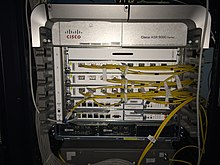
Back موجه (شبكات) Arabic ৰাউটাৰ (কম্পিউটাৰ সম্বন্ধীয়) Assamese Router AST Ruter Azerbaijani Маршрутызатар Byelorussian Маршрутизатор Bulgarian রাউটার Bengali/Bangla མདོ་འགྱེད་འཕྲུལ་ཆས། Tibetan Routaer Breton Ruter BS

A router[a] is a computer and networking device that forwards data packets between computer networks, including internetworks such as the global Internet.[2][3][4]
A router is connected to two or more data lines from different IP networks. When a data packet comes in on a line, the router reads the network address information in the packet header to determine the ultimate destination. Then, using information in its routing table or routing policy, it directs the packet to the next network on its journey. Data packets are forwarded from one router to another through an internetwork until it reaches its destination node.[5]
The most familiar type of IP routers are home and small office routers that forward IP packets between the home computers and the Internet. More sophisticated routers, such as enterprise routers, connect large business or ISP networks to powerful core routers that forward data at high speed along the optical fiber lines of the Internet backbone.

Routers can be built from standard computer parts but are mostly specialized purpose-built computers. Early routers used software-based forwarding, running on a CPU. More sophisticated devices use application-specific integrated circuits (ASICs) to increase performance or add advanced filtering and firewall functionality.
- ^ "router". Oxford English Dictionary (Online ed.). Oxford University Press. (Subscription or participating institution membership required.)
- ^ "A Router is a Computer". Cisco Network Academy. Archived from the original on 2022-07-05.
- ^ Medhi, Deepankar; Ramasamy, Karthik (2007). Network Routing: Algorithms, Protocols, and Architectures. Elsevier. p. 19. ISBN 9780120885886.
- ^ Kundu, Sudakshina (2009). Fundamentals of Computer Networks, 2nd Ed. New Delhi: PHI Learning. pp. 85–86, 124. ISBN 9788120334526.
- ^ "Overview Of Key Routing Protocol Concepts: Architectures, Protocol Types, Algorithms and Metrics". Tcpipguide.com. Archived from the original on 20 December 2010. Retrieved 15 January 2011.
Cite error: There are <ref group=lower-alpha> tags or {{efn}} templates on this page, but the references will not show without a {{reflist|group=lower-alpha}} template or {{notelist}} template (see the help page).